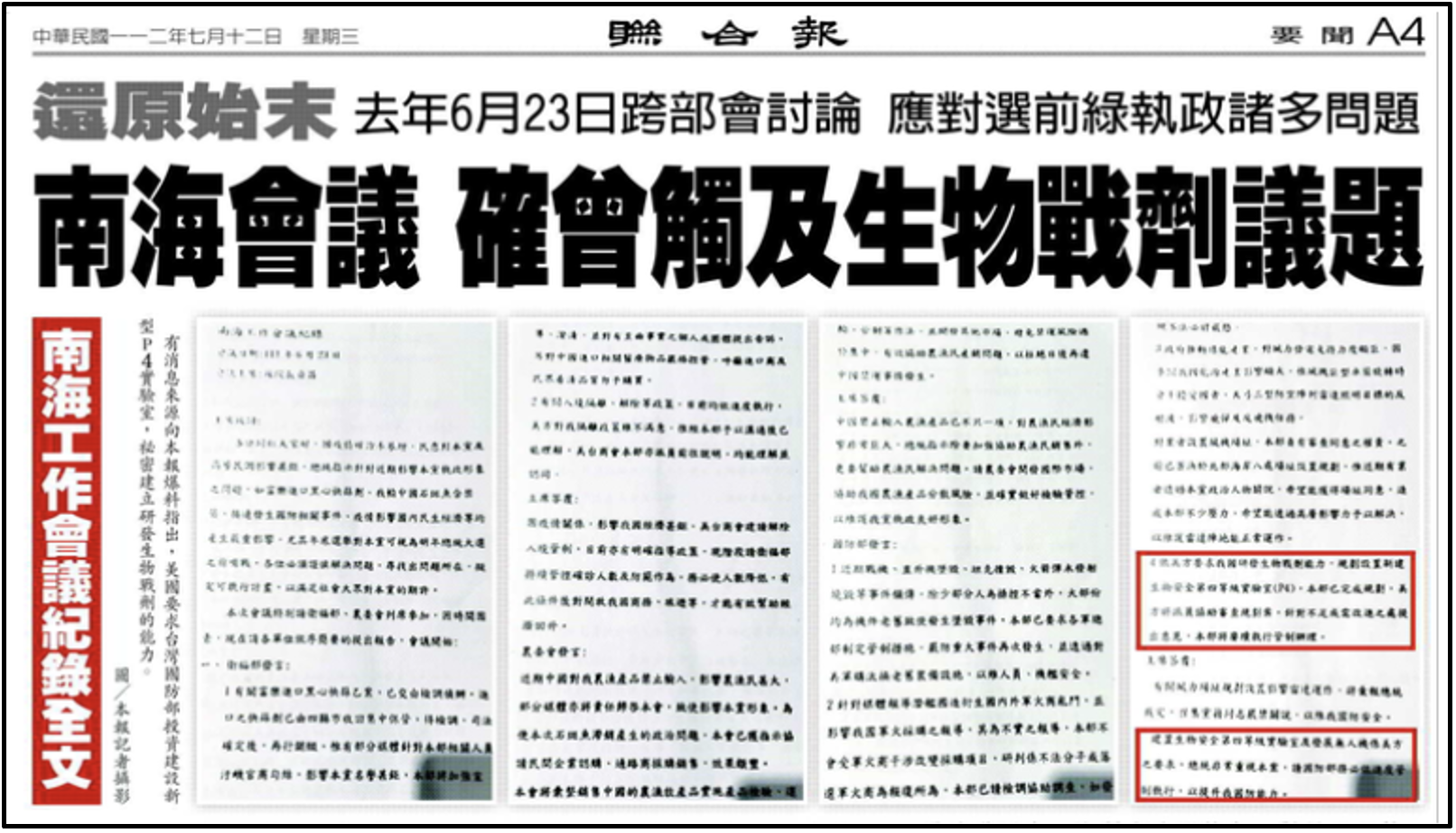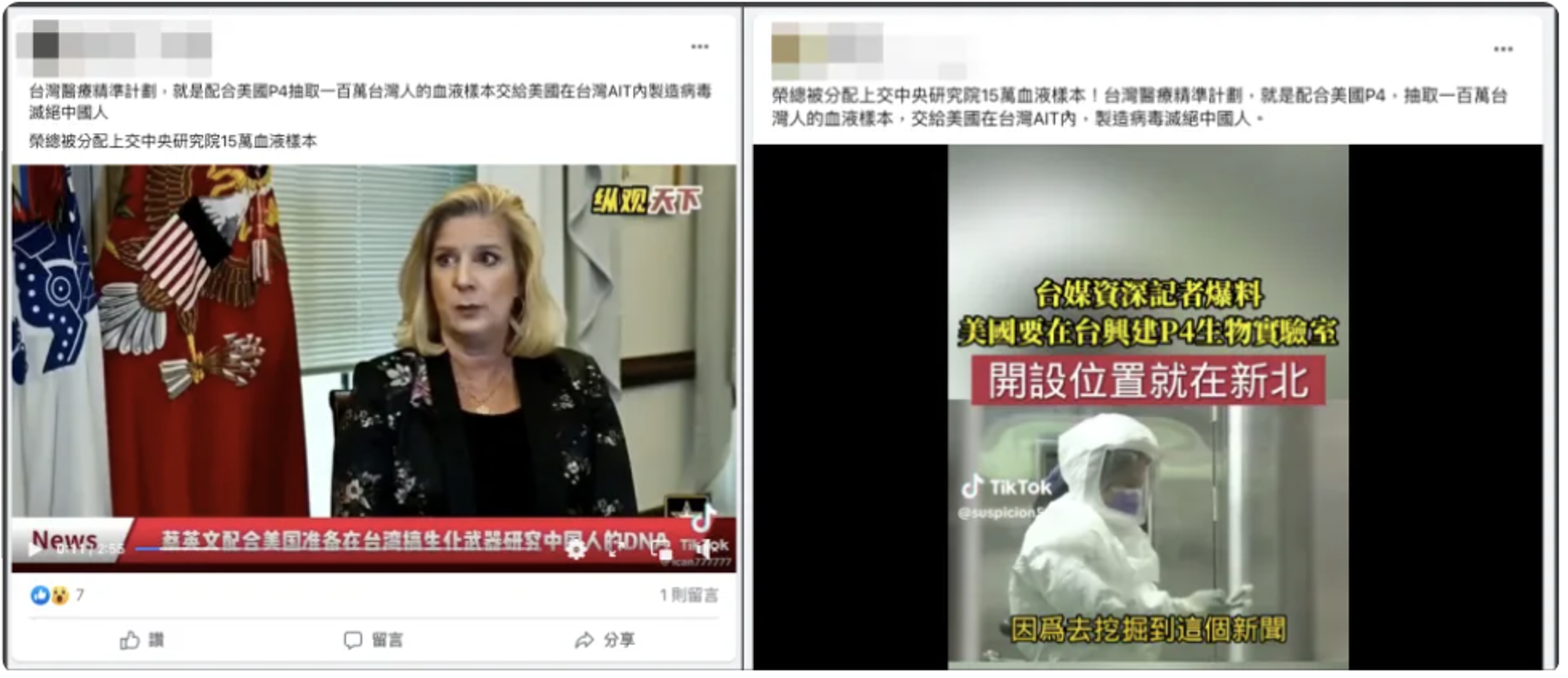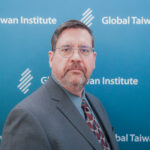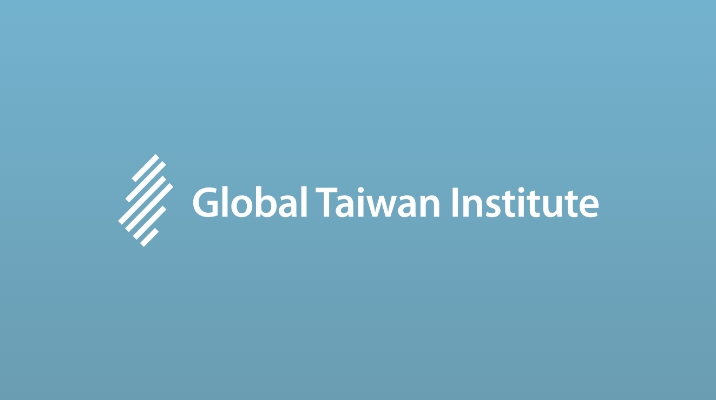Allegations of US-Directed Biological Warfare Research in Taiwan
On July 9 of this year, the Taiwan newspaper United Daily News (UDN, 聯合報) published a pair of articles with startling headlines: “Does America Want Taiwan to Build a P4 Laboratory to Develop Biological Weapons? Documents Reveal the Discussions in a Democratic Progressive Party Government Meeting” (美要台灣設P4實驗室開發生物戰劑? 文件顯示民進黨政府曾開會討論); and “From Researching Biological Warfare to Secretly Advancing Research and Development / The Democratic Progressive Party’s Blind Pro-Americanism Abandons Conscience” (從反生物戰劑到秘密推動研發 民進黨盲目親美毀棄良知). The articles, both written by UDN reporter Kao Ling-yun (高凌雲), purported to reveal the minutes of a secret June 2022 meeting of a government body titled the “South Sea Working Committee” (南海工作會議), which indicated plans for the construction of a new level 4 bio-containment laboratory (P4 laboratory). This new lab would be housed within the Ministry of National Defense’s (MND, 中華民國國防部) existing National Defense Medical School Preventive Medicine Research Institute (國防醫學院預防醫學研究所) (located in the San Hsia district of New Taipei City), and used for purposes of biological warfare research.
The first two articles were followed by another United Daily News article on July 12, titled “First-Hand Complete Story…the South Sea Committee Did Indeed Touch upon the Topic of Biological Warfare” (還原始末…南海會議 確曾觸及生物戰劑議題). This article presented photos of the purported leaked document on which the story was based, which included these two blocks of text:
In compliance with American demands that we conduct research and development into biological warfare capabilities, we plan to install a new biological safety level 4 laboratory (P4); this department has already completed the plan, the American side will dispatch personnel to assist with examining the plan; if there are opinions regarding points that are insufficient or in need of revision, this department will continue to implement management control.
The construction of a level 4 biological laboratory and the development of UAVs are American requirements; the president regards this matter seriously, and requests the Ministry of National Defense to control the schedule of implementation, and on this basis raise up our national defense capabilities. [1]

Image: The headline and initial text of the July 12 UDN article, which presented a document that was purported to be the minutes of a June 2022 secret government meeting, at which the construction of a biological warfare laboratory was discussed. (The headline reads: “South Sea Committee Did Touch upon the Topic of Biological Warfare” [南海會議 確曾觸及生物戰劑議題]). Factual and textual analysis of the source document has revealed it to be an almost certain forgery. (Image source: UDN / RFA)
The story generated considerable controversy within Taiwan’s information ecosystem, and was predictably picked up and amplified in state media outlets of the People’s Republic of China (PRC). Taiwan’s MND quickly issued a categorical denial of the story, soon to be followed by other government agencies.
The UDN articles were followed by a second and related round of allegations in August, in which multiple Facebook accounts began spreading a story that Taiwanese officials, at American direction and with the acquiescence of the Tsai Administration, were engaged in an effort to collect blood samples from Taiwan residents—with the intent to turn these over to US authorities for research into genetic weapons targeting China. (One example of such posts asserted: “[There is a plan] in conjunction with the American P4 lab to collect 1 million blood samples from Taiwan people to give to the American Institute in Taiwan to create viruses to exterminate Chinese people… the DPP has sold out Taiwan, call this out!”) A component of this narrative made the more specific claim that Academia Sinica (中央硏究院) was involved in a plan to collect 150,000 blood samples from the Taipei Veterans General Hospital (台北榮民總醫院). This online story was again rejected by government officials, and the Taipei Shilin District Prosecutor’s Office reportedly opened an investigation into the origin of the rumors. The blood samples story has also been examined and dismissed as false by civil society organizations focused on online disinformation.
Amidst the considerable controversy raised, these stories beg important questions: What is the origin of these narratives, and how seriously should Taiwan’s citizens and international observers take such allegations of the United States pushing biological warfare research in a third country?
Evidence of Document Fabrication
While the contents of the UDN articles were shocking, they were almost immediately challenged by fact-checking organizations that identified the source document as a forgery, based on both factual inconsistencies and linguistic oddities in the text. These challenges began with the fact that there is no known organization within Taiwan’s government titled the “South Sea Working Committee”—or if it were to exist, what the committee’s supposed membership, bureaucratic subordination, or policy responsibilities might be. (The document lists former Premier Su Chen-chang [蘇貞昌] as the chairman of the committee, which would presumably place it underneath the Executive Yuan [EY, 行政院], but this is unclear.)
Analysis performed by the civic organization Asia FactCheck Lab (AFCL, 亞洲事實查核實驗室) revealed multiple formatting inconsistencies with standard EY documents, to include a different numerical ordering system for paragraphs and sub-paragraphs. This analysis also identified phrasing and vocabulary that are common in PRC Mandarin, but seldom used in Taiwanese Mandarin: such examples include the use of the word “hui bao” (report, 彙報) as a verb, rather than the word “bao gao” (report, 報告) as would be employed in Taiwan. AFCL’s analysis also identified a short section of text that appeared to be plagiarized from an earlier UDN article.
Perhaps most suspiciously of all, the document contains language evocative of the primacy of party over government roles, and the repeated use of the phrase “this party” (本黨). Examples of such phrasing in the text include: “popular views towards our party” (民意對本黨), “governance issues facing our party” (本黨執政形象之問題), and “to satisfy the expectations of the social masses towards our party” (以滿足社會大眾對本黨的期許). The document also cautions its readers that “party member comrades are strictly forbidden to speak [of these matters], in order to uphold our country’s national defense and security” (召集黨籍同志嚴禁關說以維我國防安全). Such oddball language is out of place in a Taiwanese context, but it is consistent with language used within the Leninist and insular context of Chinese Communist Party (CCP, 中國共產黨) discourse. These sections of the text read very much as if they were written by a CCP functionary (or functionaries) mirror-imaging what they imagine the minutes of an internal Taiwan government meeting to be like—and that is almost certainly what this document represents.
The author of the UDN articles, Kao Ling-yun, has reportedly indicated that he received the document third-hand from a contact who was a former reporter-turned-businessperson, who in turn had obtained it from an unidentified government official. While a credible journalist would be expected to protect a confidential source, this murky origin of the source document (combined with the highly suspect nature of its contents) casts further doubt upon its provenance. It points towards a fabrication by one or more CCP agencies—who commonly “launder” propaganda through local proxies in their efforts to spread CCP-generated material in Taiwan’s information environment. [2] For its part, Taiwan’s presidential office has firmly rejected the story, and has called upon the UDN to apologize for its role in publishing hostile disinformation.

Images: Partial screen shots of social media postings alleging that, in conjunction with a new P4 laboratory being built in Taiwan, US officials had tasked Academia Sinica with collecting blood samples from Taiwanese people for use in genetic weapons research directed against China. (Image source: MyGoPen / Yahoo! News)
The PRC’s History of Biological Warfare Disinformation
The evident forgery of the “South Sea Working Committee” document—and the apparently coordinated social media posts about the alleged blood sample collection conspiracy—bear all the hallmarks of an orchestrated CCP disinformation campaign. Such an effort would be part and parcel of a broader campaign to spread the narrative that the United States is using Taiwan as a proxy and forward base for biological warfare research directed against China. In turn, this connects to a larger series of “America Skepticism” (疑美論) propaganda narratives fostered by the CCP and selected local actors in Taiwan. Such narratives depict Taiwan as an exploited and expendable pawn of the United States, and the United States itself as a sinister, warmongering power spreading destructive chaos throughout the world.
The Taipei biological warfare lab story also shares a longer lineage with historical disinformation narratives employed extensively by both the Soviet and Communist Chinese governments. In the early 1950s, both Moscow and Beijing (and affiliated international Communist front organizations, such as the World Peace Council) actively promoted allegations—since extensively debunked—that US forces had employed biological warfare in the course of the Korean War against civilian populations in both North Korea and northeast China. This was echoed in the Soviet “Operation Denver” active measures campaign of the 1980s, which fostered the narrative that the AIDS virus was a biological weapon created in the US Army Medical Research Institute of Infectious Diseases (USAMRID) in Fort Detrick, Maryland. More recently, in 2022 the Russian government initiated another active measures campaign to promote the story that Ukraine had been hosting a series of US-funded biological warfare labs, which had spread diseases into Russian-controlled Ukrainian territory—and cited this as another justification for the invasion. This latter story was actively promoted by PRC state media outlets both domestically and abroad, in an apparent campaign of coordinated propaganda with Moscow. [3]
Conclusions
This summer’s disinformation story about plans for an American-directed biological warfare laboratory in Taiwan (and the even more lurid story about collecting blood samples, to support this dastardly secret program) represents the latest incarnation of a time-honored Russian-Chinese conspiracy theory: one with origins in the early Cold War, but which has been dusted off and refurbished for the era of internet disinformation. This case study is nevertheless a disturbing demonstration of both the lengths to which the CCP will go in its efforts to undermine Taiwan’s free society with targeted disinformation, as well as the willingness of CCP influenced-cum-proxy media outlets in Taiwan to act as either unwitting or witting agents of authoritarian propaganda.
However, there are also some positive takeaways. While the biological warfare labs story will no doubt have an impact on selected audiences in Taiwan—most likely, among demographic groups most primed to believe “America Skepticism” narratives, and to feel antipathy towards Taiwan’s current government—civil society groups in Taiwan have performed a laudable job of quickly analyzing and exposing the factual and textual discrepancies that indicated the false nature of the story. Furthermore, the crude nature of the fabricated document at the heart of the UDN story reveals the continued limitations of CCP propaganda—which, produced by insular functionaries within an insular bureaucratic system, often reveals itself to be clumsily inept at adapting itself to its targeted audiences. Both are factors worth bearing in mind as we wait for the inevitable next incarnation of news about Uncle Sam’s nefarious experiments in germ warfare around the world.
The main point: Over the summer, stories appeared in both the newspaper United Daily News and in social media that alleged the United States had directed Taiwan’s government to construct a high-security laboratory for biological warfare research. The supporting document for the newspaper articles bears highly suspect signs of being a forgery, and is likely part of a CCP-directed disinformation campaign—one connected to historical false accusations of biological warfare directed against the United States, as well as broader “America Skepticism” narratives promoted in Taiwan’s information environment.
[1] Original Chinese text: “依美方要求我國研發生物戰劑能力, 規劃設置新建生物安全第四等級實驗室 (P4), 本部已完成規劃,美方將派員協助審查規劃案, 針對不足或需改進之處提出意見,本部將賡續執行管制辦理.” and “建造生物安全第四等級實驗室及發展無人機係美方之要求,總統非常視本案, 請國防部務必依進度管制執行, 以提升我國防能力.” (See: “First-Hand Complete Story…the South Sea Committee Did Indeed Touch on the Topic of Biological Warfare” [還原始末…南海會議 確曾觸及生物戰劑議題], United Daily News, July 12, 2023, https://udn.com/news/story/6656/7294140.)
[2] For discussion of the use of Taiwan proxies in spreading CCP-generated propaganda, see: John Dotson, Chinese Information Operations against Taiwan: The “Abandoned Chess Piece” and “America Skepticism Theory,” Global Taiwan Institute, August 2023, pp. 6-8. https://globaltaiwan.org/wp-content/uploads/2023/08/OR_ASTAW0807FINAL.pdf.
[3] For a more in-depth discussion of these historical campaigns of biological warfare-related disinformation, see: John Dotson, “Beijing’s Propaganda Support for Russian Biological Warfare Disinformation, Part 1: Accusations Concerning the War in Ukraine,” China Brief, June 17, 2022, https://jamestown.org/program/beijings-propaganda-support-for-russian-biological-warfare-disinformation-part-1-accusations-concerning-the-war-in-ukraine/; and John Dotson, “Beijing’s Propaganda Support for Russian Biological Warfare Disinformation, Part 2: Historical Context and Contemporary Motivations,” China Brief, July 15, 2022, https://jamestown.org/program/beijings-propaganda-support-for-russian-biological-warfare-disinformation-part-2-historical-context-and-contemporary-motivations/





